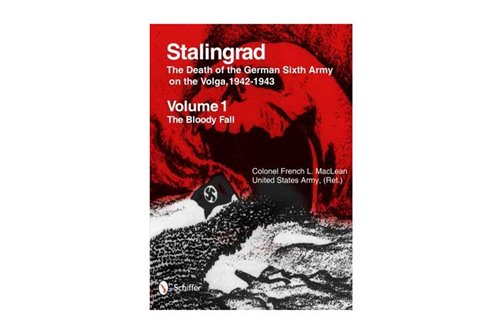- -25%




Stalingrad: The Death of the German Sixth Army on the Volga, 1942-1943: Volume 1: The Bloody Fall. Volume 2: The Brutal Winter by French MacLean.
In English.
The first volume starts on 15 august 1942 (when Sixth army reached Don River N Kalach) and ends on 31 October 1942, while the second one covers the remaining period.
After introduction, the main text offers a strictly chronological format, a day-by-day presentation, what the units of the Sixth Army were doing (disposition, casualties, neighbors etc) from 15 august 1942 to the final surrender on 2 February 1943.
Each day starts with light and weather data and ends with sources of the information.
The study is well-crafted and edited in a two-volume set inserted in a black handy binder.
I was very impressed by the numerous remembrance/death cards or letters home from the German soldiers, obviously included to present a human-interest side.
A short chapter deals with casualties sustained by Sixth Army and their allies, with a focus on POWs fate and number, followed by an epilogue. There are many color maps and photos of Stalingrad area and 4 appendices.
I see appendix 4 (“Sixth army report of autopsy”) as a short and interesting conclusion of this study.
 Security policy
Security policy
(edit with the Customer Reassurance module)
 Delivery policy
Delivery policy
(edit with the Customer Reassurance module)
 Return policy
Return policy
(edit with the Customer Reassurance module)

Stalingrad: The Death of the German Sixth Army on the Volga, 1942-1943: Volume 1: The Bloody Fall. Volume 2: The Brutal Winter by French MacLean.
In English.
The first volume starts on 15 august 1942 (when Sixth army reached Don River N Kalach) and ends on 31 October 1942, while the second one covers the remaining period.
After introduction, the main text offers a strictly chronological format, a day-by-day presentation, what the units of the Sixth Army were doing (disposition, casualties, neighbors etc) from 15 august 1942 to the final surrender on 2 February 1943.
Each day starts with light and weather data and ends with sources of the information.
The study is well-crafted and edited in a two-volume set inserted in a black handy binder.
I was very impressed by the numerous remembrance/death cards or letters home from the German soldiers, obviously included to present a human-interest side.
A short chapter deals with casualties sustained by Sixth Army and their allies, with a focus on POWs fate and number, followed by an epilogue. There are many color maps and photos of Stalingrad area and 4 appendices.
I see appendix 4 (“Sixth army report of autopsy”) as a short and interesting conclusion of this study.